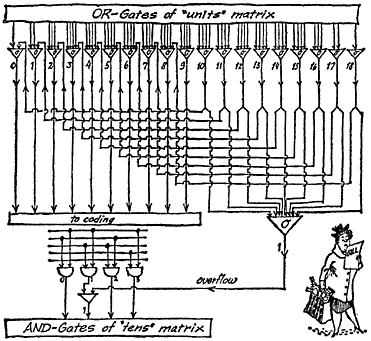Adding by Computer II
If you wish to continue adding other numbers, you must lead the total you have just obtained - and have already recoded - once more through the wires "a" to "e" into the adder matrix, and at the same time let a new number flow in from the punched tape over the wires "f" to "k" (Illus. 18). The result is a new total, which again ... and so on.
But what happens, you may feel inclined to ask, when the total is larger than 9? We know that the matrix admits totals up to 18, but just what use are they? According to our schedule, a number larger than 9 can neither be coded nor fed into the matrix.
And not only that, what about single-digit numbers? We don't need an electronic computer for those!
Of course not. For numbers with several digits there are several matrices; there is a special matrix for the hundred thousands, one for ten thousands . . . down to the hundreds, the tens and the units. Also we add up, in a single matrix, first the units, then the tens, then the hundreds ... but we shall have more to say about that later on.
But what happens if, while we are adding, a number comes out that is larger than 9 - a 17 for instance? Then the electronic computer does the sum like a schoolboy: it writes down 7, and "carries" 1! The seven stays in the unit matrix. It is forwarded to the or-gate for "7." The one that is "carried," the "overflow," is conducted to the "tens" matrix, and there fed into the or-gate for "l."
Perhaps it would be as well to make another drawing to show what happens when there is a transfer from the "units" matrix to the "tens" matrix:

Illus. 22
You are now fully informed about the adding mechanism of an electronic computer. With a little imagination you will now be able to form a vivid idea of what goes on if the thirty-six items in a grocery bill, for example, have to be added up. (Electronic computers in mail-order firms concern themselves with this kind of thing.) When the order is noted, the separate items are punched by the girl in the shipping department on a teleprinter into a paper tape, which is then fed to the computer. One amount after another makes its way into the adder matrix, where it is ... but stop! Something must surely be wrong?
Something is, indeed. There's a snag. The adder matrix can of course never total more than two numbers, and the pulses of the two numbers must without fail run into the matrix from two sides at exactly the same time. Otherwise the and-gates will not respond. But the numbers come from the punched tape one after another, not all at the same time! And, furthermore, if the two first numbers are added together, how are you going to add to them, at just the right moment, the pulses for the third number? And the other thirty-three? And ... and ... ?
©
by PhiloPhax & Lauftext
& Redaktion Lohberg
Kybernetik
- Was ist das?
First printed in Germany: 1963